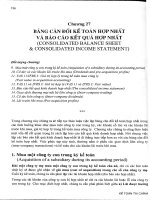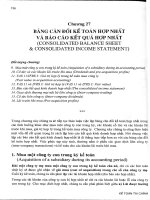Gíao trình kế toán bằng tiếng anh ch03
Bạn đang xem bản rút gọn của tài liệu. Xem và tải ngay bản đầy đủ của tài liệu tại đây (1.87 MB, 69 trang )
Chapter 3
Process Costing
Learning Objectives
After studying this chapter, you should be able to:
[1] Understand who uses process cost systems.
[2] Explain the similarities and differences between job order cost and process cost
systems.
[3
Explain the flow of costs in a process cost system.
[4] Make the journal entries to assign manufacturing costs in a process cost system.
[5] Compute equivalent units.
[6] Explain the four steps necessary to prepare a production cost report.
[7] Prepare a production cost report.
3-1
Preview of Chapter 3
Managerial Accounting
Sixth Edition
Weygandt Kimmel Kieso
3-2
Nature of Process Cost Systems
Uses of Process Cost Systems
Use to apply costs to similar products that are massproduced in a continuous fashion
Examples include the production of Cereal, Paint,
Manufacturing Steel, Oil Refining and Soft Drinks
Illustration 3-1
3-3
LO 1 Understand who uses process cost systems.
Nature of Process Cost Systems
Process and Job Cost Comparison
Illustration 3-2
3-4
LO 1 Understand who uses process cost systems.
Nature of Process Cost Systems
Review Question
Which of the following items is not a characteristic of a
process cost system:
a. Once production begins, it continues until the finished
product emerges.
b. The focus is on continually producing homogenous
products.
c. When the finished product emerges, all units have precisely
the same amount of materials, labor, and overhead.
d. The products produced are heterogeneous in nature.
3-5
LO 1 Understand who uses process cost systems.
Nature of Process Cost Systems
Process Costing for Service Companies
Service companies that provide specific, nonroutine services
will probably benefit from using a job order cost system.
Those that perform routine, repetitive services will probably
be better off with a process cost system.
3-6
LO 1 Understand who uses process cost systems.
Nature of Process Cost Systems
Similarities and Differences Between Job
Order Cost and Process Cost Systems
Job Order Cost
3-7
Costs assigned to each job.
Products have unique
characteristics.
Process Cost
Costs tracked through a
series of connected
manufacturing processes
or departments.
Products are uniform or
relatively homogeneous and
produced in a large
volume.
LO 2 Explain the similarities and differences between job
order cost and process cost systems.
Nature of Process Cost Systems
Illustration 3-3
Job order cost and
process cost flow
Illustration 3-3
3-8
LO 2 Explain the similarities and differences between job
order cost and process cost systems.
Nature of Process Cost Systems
Similarities
Differences
1. Manufacturing cost
elements.
1. Number of work in
process accounts used.
2. Accumulation of the
costs of materials, labor,
and overhead.
2. Documents used to track
costs.
3. Flow of costs.
3. Point at which costs are
totaled.
4. Unit cost computations.
3-9
LO 2 Explain the similarities and differences between job
order cost and process cost systems.
Nature of Process Cost Systems
Illustration 3-4
Job order versus
process cost systems
3-10
LO 2 Explain the similarities and differences between job
order cost and process cost systems.
Nature of Process Cost Systems
Review Question
Indicate which of the following statements is not correct:
3-11
a.
Both a job order and a process cost system track the same
three manufacturing cost elements – direct materials, direct
labor, and manufacturing overhead.
b.
In a job order cost system, only one work in process account is
used, whereas in a process cost system, multiple work in
process accounts are used.
c.
Manufacturing costs are accumulated the same way in a job
order and in a process cost system.
d.
Manufacturing costs are assigned the same way in a job order
and in a process cost system.
LO 2
Indicate whether the following statements are true or false.
False
1. A law firm is likely to use process costing for major
True
2. A manufacturer of paintballs is likely to use process
lawsuits.
costing.
False
3. Both job order and process costing determine product
costs at the end of a period of time, rather than when a
product is completed.
False
4. Process costing does not keep track of manufacturing
overhead.
3-12
LO 2
Nature of Process Cost Systems
Process Cost Flow
Tyler Company manufactures roller blade and skateboard wheels
that it sells to manufactures and retail outlets. Manufacturing
consists of two processes: machining and assembly. The Machining
Department shapes, hones, and drills the raw materials. The
Assembly Department assembles and packages the parts.
Illustration 3-5
3-13
LO 3 Explain the flow of costs in a process cost system.
Nature of Process Cost Systems
Assigning Manufacturing Costs
3-14
Accumulation of materials, labor, and overhead costs is
same as in job order costing.
►
Debit Raw Materials Inventory for purchases of raw
materials.
►
Debit Factory Labor for factory labor incurred.
►
Debit Manufacturing Overhead for overhead cost
incurred.
Assignment of the three manufacturing cost elements to
Work in Process in a process cost system is different from
a job order cost system
LO 4 Make the journal entries to assign manufacturing
costs in a process cost system.
Nature of Process Cost Systems
Material Costs
3-15
A process cost system requires fewer material requisition
slips than a job order cost system.
►
Materials are used for processes and not specific
jobs.
►
Requisitions are for larger quantities of materials.
►
Journal entry to record materials used:
LO 4 Make the journal entries to assign manufacturing
costs in a process cost system.
Nature of Process Cost Systems
Factory Labor Costs
3-16
Time tickets may be used in both systems.
All labor costs incurred within a production department are
a cost of processing.
The journal entry to record factory labor costs:
LO 4 Make the journal entries to assign manufacturing
costs in a process cost system.
Nature of Process Cost Systems
Manufacturing Overhead Costs
3-17
Objective of assigning overhead is to allocate overhead to
production departments on objective and equitable basis.
Use the activity that “drives” or causes the costs.
Machine time used - primary driver.
Journal entry to allocate overhead:
LO 4 Make the journal entries to assign manufacturing
costs in a process cost system.
3-18
Nature of Process Cost Systems
Transfers
Monthly Entry to transfer goods to next department:
Entry to transfer completed goods to Finished Goods:
Entry to record Cost of Goods sold at the time of sale:
3-19
LO 4
Nature of Process Cost Systems
Review Question
In making the journal entry to assign raw materials
costs:
a. The debit is to Finished goods Inventory.
b. The debit is often to two or more work in process
accounts.
c. The credit is generally to two or more work in
process accounts.
d. The credit is to Finished Goods Inventory.
3-20
LO 4 Make the journal entries to assign manufacturing
costs in a process cost system.
Blue Diamond Company manufactures ZEBO through two
processes: blending and bottling. In June, raw materials used
were Blending $18,000 and Bottling $4,000. Factory labor costs
were Blending $12,000 and Bottling $5,000. Manufacturing
overhead costs were Blending $6,000 and Bottling $2,500. The
company transfers units completed at a cost of $19,000 in the
Blending Department to the Bottling Department. The Bottling
Department transfers units completed at a cost of $11,000 to
Finished Goods. Journalize the assignment of these costs to
the two processes and the transfer of units as appropriate.
3-21
LO 4 Make the journal entries to assign manufacturing
costs in a process cost system.
Journalize the assignment of these costs to the two processes.
To Record Materials Used:
Work in Process—Blending
18,000
Work in Process—Bottling
4,000
Raw Materials Inventory
22,000
To Assign Factory Labor to Production:
Work in Process—Blending
12,000
Work in Process—Bottling
5,000
Factory Labor
3-22
17,000
LO 4
Journalize the assignment of these costs to the two processes.
To Assign Overhead to Production:
Work in Process—Blending
6,000
Work in Process—Bottling
2,500
Manufacturing Overhead
3-23
8,500
LO 4 Make the journal entries to assign manufacturing
costs in a process cost system.
Journalize the transfer of units as appropriate.
To Record Transfer of Units to the Bottling Department:
Work in Process—Bottling
19,000
Work in Process—Blending
19,000
To Record Transfer of Units to Finished Goods:
Finished Goods Inventory
Work in Process—Bottling
3-24
11,000
11,000
LO 4 Make the journal entries to assign manufacturing
costs in a process cost system.
Equivalent Units
Illustration: Suppose you have a work-study job in the office
of your college’s president, and she asks you to compute the
cost of instruction per full-time equivalent student at your
college. The college’s vice president for finance provides the
following information.
Costs:
Total cost of instruction
Illustration 3-6
$9,000,000
Student population:
3-25
Full-time students
900
Part-time students
1,000
LO 5 Compute equivalents units.









